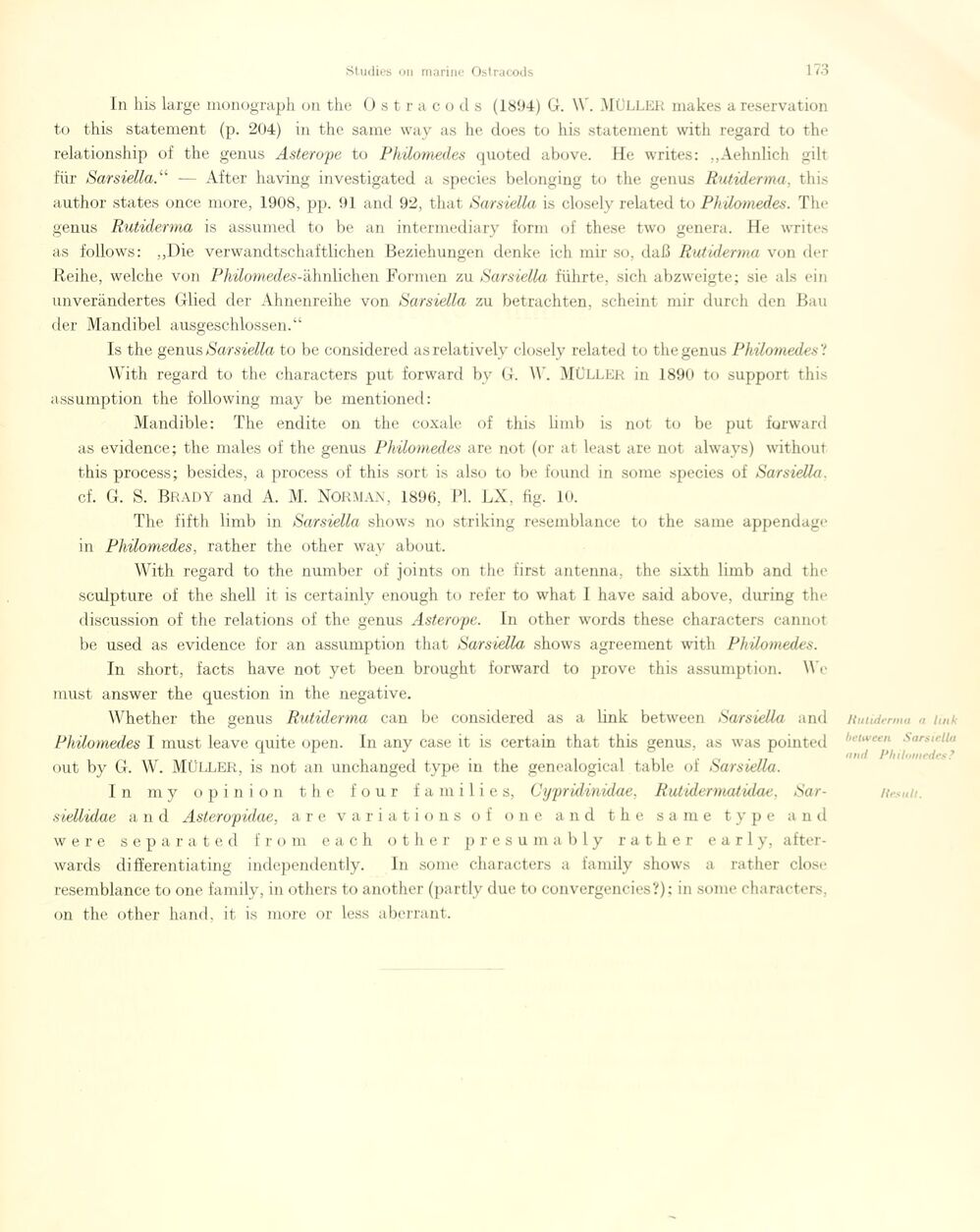
Full resolution (JPEG) - On this page / på denna sida - Sidor ...

<< prev. page << föreg. sida << >> nästa sida >> next page >>
Below is the raw OCR text
from the above scanned image.
Do you see an error? Proofread the page now!
Här nedan syns maskintolkade texten från faksimilbilden ovan.
Ser du något fel? Korrekturläs sidan nu!
This page has never been proofread. / Denna sida har aldrig korrekturlästs.
In his large monograph on the Ostracods (1894) G. W. Müller makes a reservation
to this statement (p. 204) in the same way as he does to his statement with regard to the
relationship of the genus Asterope to Philomedes quoted above. He writes: ,,Aehnlieh gilt
für Sarsiella.“ — After ha ving investigated a species belonging to the genus Rutiderma, this
author states once more, 1908, pp. 91 and 92, that Sarsiella is closely related to Philomedes. The
genus Rutiderma is assumed to be an intermediary form of these two genera. He writes
as follows: „Die verwandtschaftlichen Beziehungen denke ich mir so, daß Rutiderma von der
Reihe, welche von Philomedes-ähnliehen Formen zu Sarsiella führte, sich abzweigte; sie als ein
unverändertes Glied der Ahnenreihe von Sarsiella zu betrachten, scheint mir durch den Bau
der Mandibel ausgeschlossen.“
Is the genus Sarsiella to be considered as relatively closely rela ted to the genus Philomedes ’!
With regard to the characters put forward by G. W. MÜLLER in 1890 to support this
assumption the folio wing may be mentioned:
Mandible: The endite on the coxale of this limb is not to be put forward
as evidence; the males of the genus Philomedes are not (or at least are not always) without
this process; besides, a process of this sort is also to be found in some species of Sarsiella.
cf. G. S. BRADY and A. M. NORMAN, 1896, PI. LX, fig. 10.
The fifth limb in Sarsiella shows no striking resemblance to the same appendage
in Philomedes, rather the other way about.
With regard to the number of joints on the first antenna, the sixth limb and the
sculpture of the shell it is certainly enough to refer to what I have said above, during the
discussion of the relations of the genus Asterope. In other words these characters cannot
be used as evidence for an assumption that Sarsiella shows agreement with Philomedes.
In short, facts have not yet been brought forward to prove this assumption. We
must answer the question in the negative.
Whether the genus Rutiderma can be considered as a link between Sarsiella and
Philomedes I must leave quite open. In any case it is certain that this genus, as was pointed
out by G. W. MÜLLER, is not an unchanged type in the genealogical table of Sarsiella.
In my opinion the four families, Cypridinidae, Rutidermatidae,
Sar-siellidae and Asteropidae, are variations of o ne and the same type and
w e r e separated from each other presumably rather early,
after-wards differentiating indcpendently. In some characters a family shows a rather close
resemblance to one family, in others to another (partly due to convergencies?); in some characters,
on the other hånd, it is more or less aberrant.
Rutiderma a link
be liv een Sarsiella
tind Philomedes?
Result.
<< prev. page << föreg. sida << >> nästa sida >> next page >>